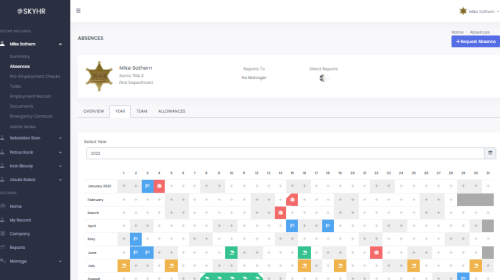Understanding the myriad types of employee leave is pivotal for any HR professional. It’s not just about compliance with legal mandates; it’s also about ensuring a supportive work environment. Efficient leave management is a cornerstone of HR processes, and it directly influences employee satisfaction and business operations.
Understanding Statutory Leaves
Statutory leaves are the cornerstone of employee rights in the UK, mandated by law and forming a critical part of any employment contract. These leaves not only ensure compliance with legal standards but also contribute to the well-being and work-life balance of employees. Let’s break down the different types of statutory leaves and their key aspects.
Annual Leave
Annual Leave, also known as holiday leave, is a fundamental right of every employee in the UK. Workers are typically entitled to 5.6 weeks (28 days) of paid leave per year. This entitlement can include public holidays, depending on the terms of the employment contract. Employers can set specific times for leave, like a Christmas shut-down, but must allow employees to use their full entitlement.
Public Holidays
In the UK, there are usually eight public holidays (sometimes referred to as bank holidays) each year. These can vary in Scotland and Northern Ireland. While there is no statutory right to paid leave on these days, many employment contracts include public holidays as part of the annual leave entitlement. Employers must clarify this in the contract terms.
Sick Leave
Sick Leave entitles employees to time off due to illness. After four consecutive days of illness (including non-working days), employees may qualify for Statutory Sick Pay (SSP) for up to 28 weeks. The eligibility criteria and reporting requirements for sick leave can vary by employer but must adhere to the minimum legal standards.
Maternity Leave
Maternity Leave is available to pregnant employees and can start 11 weeks before the expected week of childbirth, extending up to 52 weeks. The first 26 weeks are known as ‘Ordinary Maternity Leave’, and the remaining 26 weeks are ‘Additional Maternity Leave’. Statutory Maternity Pay (SMP) is available for up to 39 weeks, subject to certain eligibility conditions.
Paternity Leave
Paternity Leave provides fathers or partners of the mother (including same-sex partners) the opportunity to take time off to care for the baby or support the mother. Eligible employees can take one or two consecutive weeks of leave, receiving Statutory Paternity Pay (SPP) if they meet certain criteria.
Parental Leave
Parental Leave allows parents to take time off to look after their child’s welfare, typically unpaid. This leave can be up to 18 weeks for each child, taken before the child’s 18th birthday. Employers have the flexibility to set certain conditions on how this leave can be taken.
Adoption Leave
Similar to Maternity and Paternity Leaves, Adoption Leave is available when an employee adopts a child. This leave can be up to 52 weeks, with the first 26 weeks as ‘Ordinary Adoption Leave’ and the next 26 weeks as ‘Additional Adoption Leave’. Eligible employees can receive Statutory Adoption Pay (SAP) for up to 39 weeks.
Each of these statutory leaves plays a vital role in maintaining the balance between work and personal life for employees, while ensuring that businesses operate within the legal framework set by UK employment law. It’s essential for employers and HR professionals to understand these leaves in detail to manage them effectively and support their workforce.
Workplace-Specific Leaves: Beyond the Basics
Workplace-specific leaves are those that vary from one organisation to another, reflecting the company’s culture, values, and operational needs. These leaves are not mandated by law but are often offered by employers as part of their employment package to attract and retain talent. Here’s a closer look at some common types of workplace-specific leaves:
Compassionate/Bereavement Leave
Compassionate Leave, or Bereavement Leave, is provided to employees dealing with a family emergency, such as the serious illness or death of a close family member. The duration and pay for this leave can vary greatly among employers. Some companies offer a few days of paid leave, while others may offer more extended periods, depending on the situation and the employee’s relationship to the deceased or ill family member.
Garden Leave
Garden Leave, also known as Gardening Leave, is a unique form of leave often used when an employee is serving their notice period, typically after resigning or being dismissed. During this period, the employee remains on the payroll and receives their regular salary, but is not required to work. The purpose is to keep the employee out of the competitive marketplace for a certain period, ensuring they don’t take sensitive company information to a new employer.
Study/Exam Leave
Study or Exam Leave is offered to employees pursuing educational qualifications that may benefit their role or the company. This leave allows employees to take time off for significant study commitments or to sit exams. It can be paid or unpaid and varies in length. Employers offering this type of leave usually view it as an investment in their workforce, enhancing the skills and knowledge within their organisation.
Sabbatical/Career Break
A Sabbatical or Career Break is an extended period of leave, which can range from a few months to a year or more. It’s usually unpaid leave and is taken for various reasons, such as personal development, travel, study, or volunteering. Sabbaticals are more common in academic roles but are increasingly being offered by companies as a way to retain employees seeking a longer break from work.
Volunteer Leave
Volunteer Leave is a relatively new concept where employees are granted time off to engage in volunteer work, often in programs supported or recognised by their employer. This type of leave can be paid or unpaid and is seen as a way for companies to give back to the community while allowing employees to engage in meaningful work outside their regular job responsibilities.
Duvet Days
Duvet Days are a modern, flexible type of leave that allow employees to take unscheduled days off for mental well-being, separate from traditional sick or annual leave. Designed to reduce stress and prevent burnout, they offer a spontaneous break when employees feel unable to work but are not physically ill. This concept, originating in the UK, reflects a growing recognition of mental health in the workplace and fosters a culture of trust and support between employers and employees.
Each of these workplace-specific leaves requires tailored management, reflecting the company’s unique culture and operational requirements. By offering these types of leaves, employers can demonstrate their commitment to employee well-being and social responsibility, contributing to a positive workplace environment and enhanced employee engagement.
Health-Related Leaves: Supporting Employee Wellbeing
Health-related leaves are critical in supporting the physical and mental wellbeing of employees. These types of leaves go beyond the statutory sick leave and focus on specific health needs that may require time away from work. Understanding and accommodating these leaves is a key part of creating a supportive and inclusive workplace.
Mental Health Leave
Mental Health Leave is increasingly being recognised as equally important as leave for physical health issues. While it often falls under the broader category of sick leave, some organisations are beginning to specify mental health as a distinct reason for absence. This leave can be used for a range of mental health issues, from stress and anxiety to more severe conditions. The aim is to provide employees with the time and space needed to recover, seek treatment, or attend counselling sessions.
Disability Leave
Disability Leave caters to employees with disabilities who may need time off for various reasons related to their disability. This can include regular medical appointments, therapy sessions, or unexpected health issues stemming from their disability. Disability leave is not only about time off; it’s also about providing reasonable accommodations and support to ensure employees with disabilities can work effectively. This leave can be planned or unplanned and may vary in length depending on the individual’s needs.
Long-Term Health Condition Leave
Long-Term Health Condition Leave is designed for employees with chronic or ongoing health conditions that may not be classified as a disability but still require regular or intermittent time off. Conditions like diabetes, arthritis, or heart disease can necessitate frequent medical appointments, treatment sessions, or days off during flare-ups. Managing this type of leave requires a balance between supporting the employee’s health needs and maintaining effective workforce planning.
Cancer Care Leave
Cancer Care Leave is a specialised form of leave for employees undergoing cancer treatment or care. This leave acknowledges the intense and often unpredictable nature of cancer treatment, including chemotherapy, radiation, surgery, and recovery time. It provides the flexibility and support needed for both the physical and emotional challenges faced during this period.
In managing health-related leaves, the focus should be on empathy, confidentiality, and flexibility. Each case may be unique, requiring a tailored approach. Clear policies, open communication, and a supportive workplace culture are essential. These types of leaves not only help employees manage their health and wellbeing but also contribute to a more inclusive and understanding work environment.
Special Circumstances Leaves: Catering to Unique Needs
Special circumstances leaves are designed to accommodate less frequent, but equally important, situations that require employees to take time off. These leaves acknowledge the varied and sometimes unpredictable nature of life events and responsibilities that fall outside the usual scope of statutory and workplace-specific leaves.
Jury Service Leave
Jury Service Leave is provided to employees who are called to serve as jurors in court. This civic duty is a legal obligation, and employees are entitled to take the necessary time off for it. The duration of this leave depends on the length of the jury service, which can be unpredictable. Employers often have policies in place to either continue paying the employee’s salary during this period or to provide a supplement to the government allowance for jury service.
Military Leave
Military Leave is for employees who are members of the reserve armed forces, such as the Army Reserve in the UK. This leave allows them to fulfil their military commitments, which could include training sessions or being called into active duty. The terms of military leave, including pay and duration, can vary and are often dictated by a combination of employer policy and legal requirements.
Time Off for Dependants
Time Off for Dependants allows employees to deal with emergencies involving a dependant. A dependant could be a spouse, partner, child, grandchild, parent, or someone who depends on the employee for care. This leave is usually short-term and unplanned, allowing employees to address issues such as a child’s illness or arranging care for a dependent relative. While this leave is often unpaid, some employers may offer paid options or flexible arrangements.
Emergency Leave for Domestic Situations
Emergency Leave for Domestic Situations is a broader category that covers unforeseen personal circumstances requiring immediate attention, such as a home emergency (e.g., burglary or flood) or other urgent family matters. The scope and duration of this leave vary, with many employers offering discretionary time off to handle such situations.
Bereavement Leave for Non-Family Members
Bereavement Leave for Non-Family Members extends beyond the typical compassionate leave, acknowledging the impact of losing someone significant who may not be a direct family member, such as a close friend or long-term colleague. The provision of this leave reflects an understanding and compassionate workplace culture.
Managing special circumstances leaves requires a high degree of flexibility and understanding from employers. Each situation is unique and may require a different approach. Employers need to balance the needs of the employee with the operational requirements of the business, often on a case-by-case basis. These types of leaves, while challenging to manage, demonstrate an employer’s commitment to supporting their employees through various life events, fostering a positive and caring workplace culture.
Embracing Flexible Working Arrangements
Flexible working arrangements are increasingly important in the modern workplace. They reflect a shift towards accommodating diverse employee needs and promoting a healthy work-life balance. These arrangements can include various forms of leave or adjustments to the standard working schedule. Here’s a closer look at some of the flexible working arrangements commonly seen in today’s workplaces:
Time Off in Lieu (TOIL)
Time Off in Lieu (TOIL) is a flexible arrangement where employees who work additional hours can take corresponding time off at a later date. This system is particularly useful in managing workloads during peak periods while giving employees the flexibility to balance their time. TOIL policies vary between organisations, with some setting limits on how and when the accrued time can be taken. There are several pros and cons to TOIL that should be considered when deciding to implement it in your business.
Flexi-time Leave
Flexi-time Leave allows employees to vary their start and finish times, as long as they complete the total number of hours required in their contract. This type of arrangement is beneficial for employees who may need to start late or leave early due to personal commitments like childcare or education. It promotes a trust-based approach, where the focus is on completing the work rather than adhering to strict office hours.
Remote Working Days
Remote Working Days permit employees to work from a location other than the office, typically from home. This arrangement has gained significant traction, particularly following the shift in work patterns due to the COVID-19 pandemic. Remote working can reduce commute times, offer a more comfortable work environment, and provide flexibility for employees to manage their personal and professional responsibilities effectively.
Compressed Hours
Compressed Hours allow employees to work their contracted hours over fewer days. For example, an employee might work longer hours for four days a week and have the fifth day off. This arrangement can give employees an extra day for personal activities or rest, contributing to better work-life balance and potentially higher productivity during working days.
Annualised Hours
Annualised Hours is a system where an employee’s working hours are calculated over the whole year instead of each week or month. This arrangement provides flexibility for both the employer and employee to manage workloads according to seasonal variations or project demands. Employees might work more hours during busy periods and fewer hours when it’s quieter.
Job Sharing
Job Sharing is an arrangement where two (or sometimes more) people share the responsibilities and duties of one full-time position. Each person may work part-time hours, but together they cover all aspects of the job. This arrangement can be ideal for individuals seeking part-time employment opportunities while ensuring that the role’s responsibilities are fully met.
Embracing these flexible working arrangements can lead to a more motivated and productive workforce. It allows employees to work in a way that best suits their lifestyle and personal commitments, while still meeting their professional responsibilities. For employers, offering such flexibility can enhance employee satisfaction, reduce turnover, and attract a wider range of talent.
Best Practices in Leave Management
Effective leave management involves clear policies, open communication, and a reliable tracking system. Employers should ensure that leave policies are well-documented and communicated. Regular training sessions can help both managers and employees understand the nuances of different types of leave. SkyHR aids in this process by providing an intuitive platform for managing and tracking all types of leave.
Conclusion
Understanding and efficiently managing different types of employee leave is crucial in the modern workplace. It’s not just about legal compliance; it’s about creating a supportive and flexible working environment. SkyHR offers a solution that simplifies leave management, helping businesses to remain compliant while supporting their most valuable asset – their employees.
Call to Action
Learn more about how SkyHR can transform your leave management processes here.




